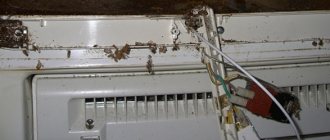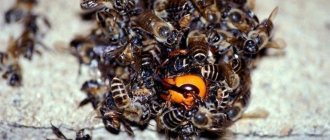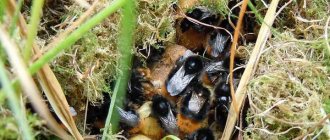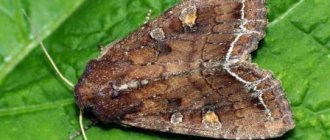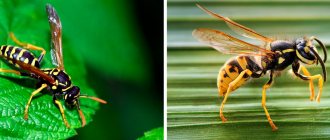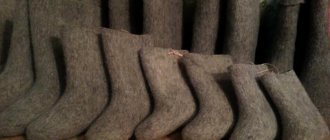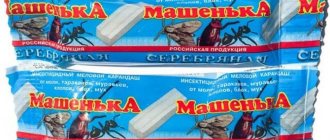Wasps often build a nest under the roof of a house in a summer cottage, in a basement or on a balcony. This causes a lot of inconvenience and is dangerous to health, because a swarm can attack, sting and spoil food. It is difficult to cope with this scourge in the summer; the wasp brotherhood does not sleep and fights back anyone who tries to attack their home. And with the onset of cold weather, the nest becomes empty. To drive away dangerous insects once and for all, you need to figure out where wasps spend the winter and whether they will return to their home after winter. Should an empty nest be destroyed?
Do wasps die in winter?
In the fall, the wasps leave their nest and disappear for several months. If it remains in the same place, the first individuals will begin to return in the spring. They also begin to disappear gradually; young females disappear in October, when the temperature in the Moscow region drops to +10 degrees.
Working females are the first to die. Their life cycle is short, only a year. Before this, at the end of summer, individuals capable of giving birth to offspring mate. Then they fall into suspended animation and fall asleep until spring in order to preserve future offspring during the frost period. By the end of November, male workers die. The old queen falls asleep forever, and in the spring a new individual will take her place. Some families give birth to fertile females only at the end of August, so their cycle is slightly shifted. Even at the end of summer, the life processes inside the wasp’s body begin to slow down until they slow down so much that the insect freezes and goes into hibernation, with fatal consequences.
As a result, only the females who store the eggs survive the winter. In the spring, the swarm will recover and return to its original place of residence. In solitary species of wasps, the queens survive the winter with their offspring inside. Male hornets die in winter, but females hide until warm days arrive and survive. Wasps choose wintering places long before the onset of cold weather.
Fighting wasps in the autumn-winter period
Prepare your sleigh in the summer, and start fighting wasps in the winter. Just because wasps have left their nests for the winter doesn't mean they won't return in the spring. Therefore, certain work must be carried out while there is no one in the nests, or rather, as soon as the temperature outside the window drops to 9 - 10 degrees. This makes the task much easier.
First of all, it is necessary to carefully examine their possible wintering places - attics, sheds, all dark and dry corners. Look into every crevice where wasps could possibly live. If boards and other things are piled up on the site “just in case,” they should be moved to another place or rearranged. If wasps were hiding there, then if they were left without a roof over their heads, they would quickly die.
If you find a nest or something similar to it, remove it carefully and destroy it. The place where you found the remains of a wasp nest must be watered with something with a strong and pungent odor. Kerosene, for example, or dichlorvos. These measures will lead to the fact that next year the wasps will look for other nesting places. In addition, before snow falls, it is necessary to collect and burn fallen leaves, if possible, remove dry branches and trees from the area, or peel off the bark from them. Thus, we will significantly reduce the number of places where wasps can hide for the winter. The right owner will not forget to replenish supplies of insecticides. In winter, they are needed much less and, accordingly, their price is lower. Whether to collect plastic bottles for traps or not is something everyone will decide for themselves. Considering that almost all liquids are sold in such bottles, it is not advisable to collect and store them all winter.
Where do they winter?
After fertilization, instinct stimulates females to search for suitable housing in which they will spend the winter. Wild wasps choose places that can retain heat. A reliable shelter is the bark of trees, in which insects gnaw holes. The walls of the wasp's winter home are saturated with saliva. This makes them stronger in order to further protect sleeping residents from bad weather and attacks. After that, they fill it with food reserves for the winter so that they have something to feed their offspring. Social wasps (paper wasps are their second name) accumulate nutrients in the body all summer, and do not wake up to snack in winter. Old stumps, firewood supplies, boards stacked for construction and wooden floors under the roof are often used to hide wasps in winter. Gaps in the walls of residential buildings, which are properly heated in winter, are also suitable.
It's good if a snowy winter comes. The aspen shelters are covered with snow and the females will calmly survive the cold. But if the weather becomes rainy, water gets into the holes and the insects die.
Expert advice: to get rid of these pests on your site, you need to try to find winter shelters and destroy them. Because if this is not done and the empty nests are simply destroyed, an unpleasant surprise may await the owners of their country house in the spring.
How to find a hornet's home?
It should be remembered:
If you begin to notice unnaturally large wasps, up to 1.8 - 2.5 cm in size, in your summer cottage or garden plot, as well as in the apiary, it means that there is a hornets nest somewhere nearby.
If you observe them in large numbers, then the home of these insects is very close. The best option to find him would be to follow the uninvited guest, because, having caught prey, he will definitely fly to his nest. But this may not happen right away, and during the flight of the hornet you can lose sight of it.
To make your search easier, you need to resort to tricks, taking special care. To do this you need:
- shoot down a hornet in mid-flight with a tennis or badminton racket;
- wearing thick gloves, take the insect and tie a thick light thread to its body, clearly visible against the background of greenery and other vegetation;
- throw the hornet to the ground, quickly moving away to a safe distance;
- follow the flying insect, which will now immediately fly to the nest.
Having discovered a hornet's home, there is no need to rush to get rid of it. Careful consideration should be given to how and when best to do this. Until then, it is undesirable to approach the nest so as not to cause aggression from its inhabitants. After all, these creatures carefully guard their home and rush to its defense with rage.
Will wasps return to a hive under a roof in the spring?
After winter, the female wasps wake up. This happens when the air warms up to +15 degrees. Now they need to find a home for the warm season in order to place their offspring in it. Their appearance will not be noticeable immediately. At first, the wasps will set up their home and actively reproduce. And by mid-summer you can observe a full hive of young individuals.
Natural instinct calls the females to return to their native land. Therefore, if you do not destroy the houses of striped insects in the winter while they are empty, then in the spring a new family will settle there. How to effectively destroy a wasp nest:
- remove and throw away away from home;
- burn;
- treat with Dichlorvos or boric acid;
- sprinkle with bleach or a special repellent compound (“Raptor”, “Get”, “Alatar”).
Important: even if the nest was physically destroyed, the place where it was located must also be treated with a chemical composition. Otherwise, wasps can simply build a new home in place of the old one in their familiar territory.
You can help move the swarm to a new location, away from people. For this purpose, comfortable areas are created, protected from bright light, wind and moisture. You can lure them with sweet fruits and water with sugar.
It was not for nothing that the wasp appeared in nature. At first glance, these insects are of absolutely no use, but rather the opposite. But in fact, striped ones destroy clouds of pests in the garden in order to feed their offspring. They also promote the reproduction of flowers and plants and carry pollen. And if you do not anger them and do not interfere with the period of conception of offspring, then wasps can exist peacefully next to humans. The life cycle is short, but they accomplish a lot in a year. Until the last days, they help the offspring survive so that the food chain is not disrupted.
How do hornets—the same giant wasps that bite so painfully—winter? After all, these insects are among those animals that are not able to maintain a high body temperature. According to the logic of the structure of the physical body, at subzero temperatures insects should become a piece of ice.
Finding a nest
In general, the hornet is a beneficial insect that does not harm humans unless it poses a danger to them. If you come across a hive in a natural area, outside the area where people live, you should not try to destroy it or destroy it, since in such cases the insect is part of the natural environment where they play an important role.
If a hornet family has settled near people, you need to be especially careful, since such proximity is dangerous, especially when setting up a hive in a frequently visited area.
They provide deadly proximity to bees, since they are capable of attacking an apiary, destroying adult representatives, larvae, and also eating honey. In the case of regular appearance of hornets in summer cottages and gardens, even with a small group of predators, you should think about starting to search for a nest. Pictures of the appearance can be seen below.
We advise you to start searching for a hive at the initial stage of its formation. The function of the base of the nest is performed by the queen, who lays the first tier and immediately lays eggs inside the honeycomb. During such a period, it is possible to destroy it without problems and much difficulty. But after several weeks, there is a rapid increase in the number of young members of the family, which will become more difficult to get rid of.
Those who sting choose a quiet, secluded place that is maximally protected from bad weather conditions - this can be a hollow inside a tree, a hole in the soil, an abandoned building, a barn, or an attic.
It is best to organize the search in the following sequence:
- Conducting preparations. Encountering such giant stinging wasps is a dangerous undertaking, so proper preparation for such a process is important - make sure you have anti-allergy medications and closed clothing made of thick fabric (you can buy a special protective suit).
- Beginning of the inspection of the premises. Carefully examine the territory of attics, basements, sheds, and outbuildings. They often build a hive in a window frame, under the floor, even in a wall - such locations are quite dangerous and the process of dealing with them will take a long period.
- Conducting an inspection of the entire territory. You need to explore the garden, trees, logs, stumps. It is also worth taking a closer look at the presence of burrows in the soil, especially under trees.
- Listen. If the inspection does not give the desired result, try to hear them - these insects make quite a lot of noise, especially during the construction of the hive.
- Tag the pest is an interesting technique that can be used when the search does not bring results. To do this, catch the hornet and mark it with a bright thread or tape, then release it and track where it goes.
Interesting fact.
Many people believe that these insects sleep at night, but this is not the case, their activity decreases, but they are still ready and will zealously defend their home in case of danger.
If you find a nest, you need to determine how dangerous its inhabitants will be for humans. It depends on the location. If you have a hive in a corner where people and insects do not intersect, leave them in peace and do not disturb their house.
If the housing is located in a frequently visited area, then destruction is required, which is very difficult, since the hornet family is always active and displays aggression for protection. Look at the photo to see what a cocoon looks like.
Among the most effective methods that suggest the ability to destroy a hive are:
- Treatment with insecticides;
- Drowning;
- Burning;
- Pouring boiling water.
The presented options are tough and risky, so they should be used only as a last resort.
Who are they, hornets?
In biological taxonomy, there is a special genus called hornets. He, in turn, is part of a family called true wasps. So it’s not for nothing that hornets are so similar to wasps. These are their closest relatives, who in their lifestyle, reproduction and feeding method are not very different from the so-called paper wasps. However, hornets still have their own biological and behavioral characteristics.
Typically, these insects are one of the largest representatives of the wasp family, live in different biotopes and are not directly associated with human homes and agricultural lands.
Area of residence
In the Northern Hemisphere, up to the 63rd parallel, the most common species is the common hornet. It can be found in Europe, North America, Kazakhstan, and Ukraine. In Russia, insects live over a vast territory from the European border to the Ural Mountains and Siberia. Even in the northern and eastern provinces of China they know what the European hornet looks like.
Interesting fact. Until the mid-19th century, hornet wasps were not found in North America. They were accidentally introduced by European sailors.
What do these big wasps eat?
These insects can be called omnivores, but still, due to their habits and preferences, they are, first of all, predators that feed mainly on other insects. However, their behavior is complex, their character is decisive, and their habits are unusual. These smart insects, brave to the point of impudence, do not shun thefts and robberies. By the way, they get food without using a sting. To do this, they only need powerful jaws. And the sting with poison exists for self-defense from large animals.
The hornet is the worst enemy of bees, capable of destroying an entire hive in a squad of several individuals. After this, the robber eats and takes to his nest everything he finds in the empty home.
Adults also feed on the fruits of some plants. They are very fond of berry juice, mainly raspberries, blackberries, strawberries, and grapes. They even more prefer to feast on sweet fruits, such as peaches, apricots, and plums.
These insects are especially fond of overripe fruits and berries that are beginning to decompose. In addition, they flock to the corpses of recently deceased animals, in whose bodies maceration has already begun, but the process of decay has not yet occurred.
Danger to humans - myth or reality?
The behavior of the common hornet differs significantly depending on the distance from the nest. During flights for food for themselves, the queen and larvae, they behave peacefully. But, when a real or imaginary danger to the nest appears, the hornets mercilessly sting everyone who falls into the zone of their aggression. There are always several individuals on duty near the house for protection. In the event of an attack, they give a special alarm signal that gathers the whole family.
How dangerous are hornets to humans? The strong venom of insects when bitten causes an attack of pain. Unpleasant sensations and swelling may persist for several days. The symptoms are similar for all victims, only the intensity of the manifestation differs.
Insects jealously defend their nest, but with careful approach, you can monitor the life of the colony. The main thing is to remember a few rules of behavior:
- do not make sudden movements;
- do not touch the nest with your hands or a stick;
- do not interfere with the flight of the hornets.
It is recommended to destroy the nests of the common hornet only if there is an increased danger in the neighborhood. For example, if it is located in a used room or next to an apiary. Predators are the worst enemies of bees and beekeepers. People with hypersensitivity to poison should get rid of the neighborhood, otherwise they will be in danger. In general, large wasps are peaceful neighbors, which will also help with the destruction of pests.
Hornet and man
The hornet does not specifically touch humans, but it is not afraid either. It settles near people because it is more convenient to build nests here. There is also a lot of food here, since various insects are always concentrated around a person. Moreover, human supplies are a source of food for the hornets themselves. For example, an adult individual under a person’s nose can fly up to a piece of meat from which a cutlet is being made, cut off a small piece for itself and fly away with the prey in its jaws. Somewhere in the forest there is no such abundance of food.
However, living next to a person is dangerous. He is the only representative of mammals that deliberately destroy the nests of these predators.
Thus, for this great wasp, man is a creature who:
- builds structures convenient for nests;
- concentrates many insects around itself;
- grows delicious fruits and berries;
- stores reserves of energy-rich food;
- breeds bees.
Hornets also play a contradictory role in human life. They:
- bite painfully;
- destroy insects - agricultural pests;
- clean areas of rotting products;
- destroy bees.
So for humans, hornets are neighbors on the planet who both help and harm. If you don't keep bees, these large wasps that settle near human habitation are more beneficial than harmful. But beekeepers have their own scores to settle with hornets.
Bottom line
To summarize, I would like to highlight the main thing - the meaning of hornets for people is very contradictory. On the one hand, they help - they destroy insects: flies, mosquitoes, ants and numerous agricultural pests, and also clean the gardens of overripe fruits.
But on the other hand, they destroy bees and can bite humans. If you are bitten by an insect, you should immediately take an antiallergic drug, and if you have multiple bites, immediately seek medical help. Thus, if you are not a beekeeper, then these large striped insects are more likely your friends than enemies.
How do these insects survive winter?
Hornets are social insects like bees or ants, in which the nest is the basis for the well-being of the species.
Hornets' homes are structures made of paper, which they make from the young bark of trees.
The nest is a round-shaped structure with honeycombs inside. This ball is hung somewhere in a secluded place. Its purpose is to place eggs in paper honeycombs and then feed the larvae there.
Insects are creatures that generally do not like to migrate far. Moreover, most of these species do not migrate at all. They prefer to live where they were born. Any mass movements of grasshoppers, called locusts, moths and other arthropods are rather an exception to the rule. So, if an insect lives where there are harsh winters, then it is adapted to survive them.
The whole rhythm of the existence of hornets in the harsh conditions of a temperate climate is similar to the rhythm of life of bees and ants. To survive and produce offspring every year, you need to sacrifice something or someone.
Ants and bees sacrifice males, who quickly die after mating. This is done in order not to waste resources on already useless individuals. In hornets, the females are in charge. They are the ones who survive the winter, and then become the founders of a new generation.
The young female leaves the parental nest towards the end of the warm period of the year, that is, at the end of August or beginning of September. At this time, the nest can reach a diameter of more than half a meter, and a length of about a meter.
During the period of maximum number of sexually mature individuals, they all leave the nest, swarm and mate. This phenomenon may seem strange, because mating occurs before the onset of cold weather. However, this is precisely the logic of successful wintering and further reproduction of offspring.
Soon after mating, the males die, and the females begin to lead a free and solitary lifestyle. They feed heavily, and in between searching for food, they look for a secluded place for winter shelter.
The wintering place should be such that a pregnant female (and this is how they sleep), having fallen into suspended animation, is completely safe. She should not be found by enemies, the cold wind, and most importantly, people. Hollows, cracks in rocks, various small cavities on the outside of human dwellings, unheated buildings, shelters under stones, fallen trunks, etc. are suitable for this.
None of the wintering insects hide inside human houses. The fact is that when cold weather sets in, when the temperature drops below 0°C, the water in the insects must freeze. However, this does not happen, because in the body of these creatures, water is replaced by glycerol, which inhibits all life processes, but most importantly, it does not turn into ice and does not break cell walls.
How hornets build nests
Hornet trap
One can only be amazed at how hornets build their nest - how much work, discipline, and self-organization is invested in this process. Insects make their homes durable and comfortable. It protects them from heat and cold.
An interesting fact is what hornets make their nests from. The materials for construction are wood and bark. Hornets especially like birch, which is why their nests are lighter than those of other wasps. Pieces of wood are thoroughly chewed, moistened with saliva, and honeycombs, walls, partitions, and shells are gradually molded from the resulting material, ball by ball.
The queen chooses the nest site. She begins to build her future home. First, the queen fashions the first ball of cells in which the eggs are laid. After about a week, the eggs turn into larvae, which, in turn, degenerate into pupae in two weeks. After another two weeks, young worker hornets fly out of the nest and continue to build housing.
How productive the work of the new generation of insects will be depends on how many hornets in the nest will develop throughout the season. After the worker hornets fly out, the eggs of future females and males are laid. They fly out already sexually mature, and immediately after their departure swarming begins.
Let's get to know each other better
The classification of insects states that there is a separate genus of hornets, which belongs to the family of true wasps. Wasps that are familiar to us belong to the same family. They are called paper wasps. Thus, hornets are their close relatives. Therefore, they are very similar to them in appearance, as well as in their method of nutrition, reproduction and general lifestyle.
However, hornets have their own characteristics, both biological and behavioral. We will focus on them in our article.
Hornets are social insects that live in large families, also called colonies. By the beginning of September, their numbers can range from 400 to 800 individuals.
The family consists of one queen, several females, males and workers. Only the queen of the colony lays eggs. Therefore, to prevent mating and laying eggs by other females of the family, the queen emits a special odor. As a result, females lay unfertilized eggs, from which only drones are born.
Hornets are larger than wasps. The size of the uterus can reach 25-35 millimeters, and males and workers 22-30 millimeters. The front half of the chest and the head of the hornet are yellow. There are rings on the body - the first two are dark brown with yellow stripes, and the rest are yellow with the presence of brown spots. The body of the insect is covered with villi.
On the top of the head are three large compound eyes of a reddish-orange color. The oral apparatus of hornets has the shape of a gnawing type, but is only equipped with very strong mandibles. Females and workers have a sting, which is a modified ovipositor.
What are the different types of insects?
There are 23 species of hornets in the world, which in turn are divided into subspecies.
The most common types include:
- European, which is distinguished by red pigmentation on the head and large body. They are found throughout the Russian Federation, including Siberia. Very common in the Primorsky Territory. Also, often found in the Moscow region.
- Eastern - the body is brown in color. They live in Asia, Africa, Europe (including the vast expanses of Russia).
- Filipino - a bite leads to the death of a person. Insects are common in the Philippines.
You should know that in some countries hornets are protected by the state. For example, in Germany, a fine of 50 thousand euros will be imposed for destroying a hornet nest.
Differences from other representatives of the species
From a zoologist's point of view, hornets and wasps belong to the same family. These insects are similar to each other in the color of their abdomen and the presence of a sting, but there are also fundamental differences between them. Some people also mistakenly believe that hornets and bees are friendly relatives, but in fact they are enemies. Next, let's look at the main differences between hornets and bees and wasps.
From the bees
Bees collect sweet honey, the smell of which attracts hornets. They can attack a bee apiary and destroy not only honey supplies, but also the bees themselves.
The appearance of these insects also varies significantly:
- size - bees are much smaller, and their body has a rounded shape;
- body color - the body of both insects is covered with fluff, but in bees the pattern is brighter and consists of black and yellow colors, and in the hornet it is black, yellow and brown;
- waist - bees do not have a sharp interception between the belly and chest;
- jaws - in bees they are smaller and not so strong;
- sting - in bees it is shorter and remains in the body of the victim after the bite, and the hornet always retracts the sting back into the abdomen;
- limbs - in bees they are thicker and covered with fluff.
Important! A family of hornets can completely destroy an apiary and destroy all the bees. Therefore, when a hornet nest appears near an apiary, it must be destroyed immediately.
From wasps
Despite the fact that from a biological point of view, wasps are “sisters” of hornets, these insects are at enmity with each other. Hornets often catch wasps to feed to their larvae.
Let's look at the main differences between a hornet and a wasp:
- size - hornets are 2 times larger than wasps, and their body is covered with fluff;
- color of the body - in wasps, the abdomen consists only of yellow and black stripes, and in hornets, brown color is added to them, and the pattern of stripes on the body of the wasp is brighter and more contrasting;
- the shape of the head - in hornets it is round and large, while in wasps it is smaller and tapers towards the base;
- the color of the cephalothorax is dark brown in hornets, and black in wasps;
- waist - in wasps it is thinner and better defined;
- size of the jaws - in the hornet they are more developed, as they serve not only for chewing food, but also for hunting other insects;
- sting - in wasps it is shorter and has small teeth.
What do they eat?
Nature created hornets as predators. Therefore, they mainly feed on other insects. They not only eat live insects, but can also feast on the carcass of a recently deceased animal. Hornets eat only those bodies in which the process of putrefaction has not yet begun. The diet of striped insects is supplemented by sweet fruits and berries, which are already beginning to decompose.
They love overripe fruits: plums, apricots, peaches, strawberries, raspberries, blackberries and grapes. With pleasure they feast on all beekeeping products. A squad of several hornets is capable of destroying an entire swarm of bees. They eat and take back to their nest everything they find in an empty hive. Thus, they can be safely classified as omnivores.
Where do the winged "pirates" live?
Hornets are called “pirates” because of their habits. They very brazenly commit robberies and thefts from other insects, in particular bees. At the same time, they act bravely and wisely. When getting their food, they use only their powerful jaws. The sting with poison is used only for self-defense from large animals and people.
Where do hornets live? They choose a variety of biotopes to live in, which are not necessarily associated with human habitation and agricultural land. Striped insects settle close to people due to the abundance of food.
- There are always many insects living around a person’s home.
- Human food supplies serve as food for hornets.
A hornet can easily fly into the kitchen and profit from something. For example, to separate a small piece of meat from a piece from which the housewife plans to cook something. Berries and fruits grow in gardens and plots. Some people keep bees. In addition, it is convenient to build nests on human structures.
Lifestyle
The rules for the existence of hornets in nature are very similar to those of bees and ants. In order to survive during the cold winter and give birth to offspring every year, insects have to sacrifice someone and something. They sacrifice males, who die soon after mating. This way resources are not wasted on already “useless” individuals.
After all, in the hornet family, the females are the main ones. Therefore, they must prepare well for hibernation, survive it, and in the spring become the founder of a new colony. The uterus needs a large amount of protein to produce eggs and develop ovaries. In order to successfully overwinter, it eats very richly and accumulates a fat body.
Mating Features
The greatest activity in the hornet family is observed at the end of the warm period of the year, namely the end of August and the beginning of September. By this period, individuals of both sexes become adults. They all leave their home, swarm and mate. Thus, mating occurs before the onset of cold weather. Female hornets spend the winter pregnant.
Males die soon after mating. Females lead a solitary lifestyle. They feed heavily, and between meals they fly around the nearby territory in search of a safe place for winter shelter. Overwintering of a pregnant female hornet, which falls into suspended animation, is possible only in a secluded place where enemies and cold winds will not find her.
Wintering conditions
Crevices in rocks, tree hollows, shelters under stones and fallen trunks, and small cavities on the outside of unheated buildings or houses are well suited for this. There is no need to be afraid that the female will hide inside a human house. There's a good reason for this. When cold weather sets in, when the air temperature drops below 0 0 C, all water freezes.
But the water in the hornets does not freeze. This is due to the fact that in the body of insects, water is replaced by glycerol. It does not freeze, but it slows down all life processes. This way, the glycerin cannot turn into ice and rupture the insect cells. If the hornet warms up prematurely, it will die during the next cold snap.
When the female hides for the winter in a heated human house, the warm air temperature will contribute to her premature awakening and the natural need to build a nest. If she manages to hide in a house from human eyes, then it will be very difficult for her to look for material to build the honeycomb of her “house”.
When she manages to build a nest, she will not be able to find enough food in the house to feed her offspring. Thus, she will doom him to certain death. Therefore, female hornets do not choose heated human houses for wintering.
The main condition for successful wintering is constant air temperature without sharp fluctuations.
A lot of female hornets die during harsh winters with little snow, as well as in the presence of winter thaws. If the female does not manage to hide well, she will become prey to various birds or small predators. Therefore, a significant number of hornets do not survive until spring.
What to do if bitten by a hornet?
A person who has been bitten by a hornet should immediately receive first aid. It should be aimed at eliminating the negative consequences of the toxic poison on the body.
Read more about how dangerous a hornet bite is for humans and how to provide first aid.
Let's look at step-by-step instructions for first aid:
- Suck out the poison from the wound created by the insect's sting. This action can only produce results if carried out within the first 2 minutes after the bite. After this time, the skin around the wound will begin to tighten and it will be impossible to remove the poison using this method.
- Take an antiallergic drug . It will stop the rapid allergic reaction and partially neutralize the insect venom. You can use any antihistamine (for example, Suprastin).
- Make a cold compress and apply it to the bite site . The cold will prevent the rapid spread of poison in the body, and will also reduce swelling and pain at the site of the bite.
- Apply any medicine against insect bites to the wound (for example, Fenistil). This will reduce redness and pain and prevent the wound from festering.
- If the victim’s body temperature has risen above +38 °C, then he should be given an antipyretic drug. If the body temperature has increased after the bite, but has not reached the specified level, then it is not recommended to bring it down - in this way the body fights the negative effects of the poison.
- The victim should not drink alcohol - alcohol enhances the negative effect of insect venom on the body.
- If your health worsens further, you should immediately consult a doctor.
